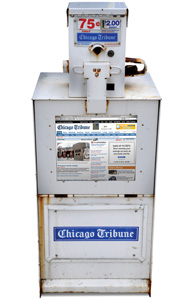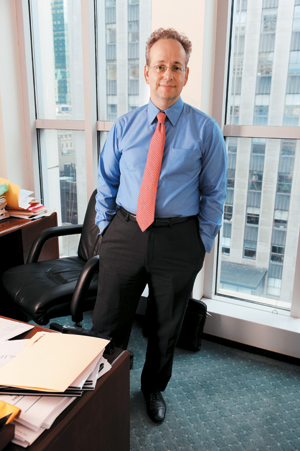Read all about it (somewhere)
As newspaper publishers hemorrhage cash, Gordon Crovitz, AB’80, launches a new business plan for the industry. But will readers pay for online news?
By Tom Mullaney, AMí68
Photo illustrations by Dan Dry and Allen Carroll
The contention between newspapers and online news reached a comedic zenith this past June, when a Daily Show reporter challenged Rick Berke, assistant managing editor of the New York Times, to show him “one thing in there that happened today.”

The point, former London Times editor Harold Evans noted in a book review, was to portray the paper as a “doomed dinosaur” that printed outdated news. Later in that episode, New York Times executive editor Bill Keller retorted that he hadn’t seen a Baghdad bureau for the Huffington Post, Google, or the Drudge Report. True, the Daily Show’s Jason Jones agreed, but the blogs are “more fun to read.”
Bloggers, joined by some news commentators and investors who have a stake in print’s demise—and even some of those whose jobs depend on print—increasingly blare its obituary, arguing that newspapers and magazines no longer meet the needs of an instantaneous, globally connected, digital world.
Yet others have a more optimistic view of newspapers’ future, including L. Gordon Crovitz, AB’80. And Crovitz is in a position to prove his point. Along with business partners Steven Brill, founder of American Lawyer and Court TV, and media investor Leo Hindery, he has developed a new business model for paid online content, meant to save an industry that’s been gushing money for at least five years.
Crovitz sees now as the time to challenge the free model of accessing news. His venture, Journalism Online, scheduled to debut publicly this fall, is designed to answer the newspaper industry’s biggest question: can publishers charge online readers without seeing their audiences evaporate?
A newsman his entire career, Crovitz had his first byline at age 14 in the Durham, North Carolina–based alternative weekly the Anvil. As a teenage radio announcer, he reported President Nixon’s resignation. During a 27-year career at Dow Jones, he rose from a Wall Street Journal intern to publisher before leaving the company in late 2007, following Rupert Murdoch’s purchase of the paper (Crovitz won’t comment on whether Murdoch’s ownership led to his departure).
Now, in his bare-bones Journalism Online office on New York’s West 52nd Street, Crovitz, 51 years old and standing 5-foot-11, wears a gray suit and wire-rimmed glasses. Named one of the 2008 Silicon Alley Insider’s top 100 in the New York digital-business community (he’s an investor in Silicon Alley Insider), he reads most of his own news online, including the Journal, Business Insider, and Paid Content. In September he joined the Minneapolis Star-Tribune’s board.
News companies have a future, Crovitz asserts, despite the unease many insiders feel as the industry undergoes both change and challenge. Publishers and editors admit they don’t know what the future holds. Crovitz, meanwhile, says flat out, “The free Internet has been an aberration. And the aberration is over.”
Two statistics encapsulate the newspapers-in-flux story. First, between 2000 and 2008, approximately 200,000 media jobs were lost, according to Advertising Age, mainly at newspapers and magazines. Second, Craigslist.com now boasts more than 47 million unique visitors every month in the United States alone, cutting into newspapers’ classified-ad sales.

In Chicago the beleaguered Tribune newsroom staff has shrunk since last December from 580 to 430. The print edition’s daily circulation has slipped to 465,892, and the Sunday edition, which reached 1.6 million in 1949, has dipped to nearly 803,220. (The company’s free tabloid Red Eye and Spanish-language Hoy, however, are climbing in circulation, according to Tribune editor Gerould Kern.) The Washington Post has gone through four rounds of buyouts but has heretofore avoided layoffs. Longtime Post political reporter David Broder, AB’47, AM’51, admits, “All of us are apprehensive. There’s nervousness in the newsroom here. The audience has migrated, and I don’t think they’re coming back.”
So the prognosis for print is unclear. “It’s chaos out there,” said Douglas Smith, executive director of the Punch Sulzberger News Media Executive Leadership Program at Columbia University’s journalism school, at a program session. Yet many news sources predict the format has a long life ahead. Print may shrink as a percentage of readership but generate revenue as a premium product, says Crovitz. “There is a future for print newspapers and magazines, but they need to change to find their place.”
Newspapers, of course, haven’t gone away. Bacon’s Media Database, the industry’s most-used media directory, shows the United States and Canada still have more than 2,100 daily papers and 12,800 weekly and college newspapers. Kenneth Paulson, former editor and a founding staff member of USA Today and now head of Washington, DC’s Newseum, thinks local and regional papers will continue to turn profits, though metropolitan dailies (for example, the Baltimore Sun, Boston Globe, and Miami Herald) are the most endangered and won’t earn their customary 20–30 percent annual returns. Compounding the steep fall-off in ad revenues, Michael Massing writes in the September 24, 2009, New York Review of Books, has been publisher greed. “The relentless stress on acquisition and consolidation…helped drain money out of newsrooms and into the pockets of shareholders.”
Although newspapers, argues Paulson, are still money-making ventures—but not as attractive an investment vehicle as they once were—many print publications are disappearing or shrinking. The Christian Science Monitor has gone from a five-times weekly schedule to a solitary weekly issue, while publishing daily online. In a column this past August, the New York Times’s David Carr described the grisly situation at the Journal News, a Gannett-owned paper in Westchester, New York. Earlier that month the news and advertising staff were asked to resign and reapply for new, redefined positions; 70 of the 288 employees were let go.
How did the situation become so dire? Newspapers never found a way to shift their business plans to the online world. Advertising had brought in money for American printed papers since at least the 1700s, so publishers tried migrating that system online, figuring they’d generate a revenue stream and more viewers while also reducing their marketing, print, and paper costs. While charging for print copies, publishers committed the “original sin,” according to Jacob Weisberg, chair and editor of the Slate Group, of providing the same content free online. And throughout the 1990s and early 2000s, online visitors, especially students and other young adults, gravitated to the free medium.
In the past decade the New York Times’s daily circulation, including home delivery, newsstand, and other sales, has plunged to 927,851, and weekday delivery rates hover around 600,000. Meanwhile its online audience has ballooned to 1.4 million daily viewers. The 1990s conventional wisdom held that those readers would click on ads and spend money with those advertisers.
The plan hasn’t worked out that way. From 2005 to 2008, print-ad revenue declined by $12.7 billion, according to the Chicago Tribune, while online ad revenue has grown by only $1 billion. It’s not all attributable to Craigslist and Google, but they are often cited as the main culprits.
Crovitz became responsible for the Wall Street Journal’s online site in 1997, a year after the paper set up a pay wall, charging visitors to access the paper’s business, news, and financial-analysis articles. He continued the pay model, following the opinion of Stewart Brand, founder of the 1960s counterculture bible the Whole Earth Catalog, who first declared, “Information wants to be free.” As Crovitz quoted him in a February 2009 Journal column, Brand added a second, often overlooked comment: “Information also wants to be expensive.” Known in those early days as the “priest of no free content,” Crovitz saw online subscriptions rise from fewer than 100,000 when he started to 1.1 million today.

At the time Crovitz’s colleagues in the profession viewed him, he admits, as a heretic. But now more publishers are adopting his view. This past May an editor/publisher told an Associated Press reporter: “To me, an online subscription is just the commonsense thing to do. To just give it all away on a Web site is completely and blindly idiotic.” Jeffrey Bewkes, chair and CEO of Time Warner, echoed the sentiment at a May 2009 business conference. “It makes no sense…to run a publishing business with no cost for the content.” The Post’s Broder takes it a step further: “I believe that if we can charge for content, we can save the print franchise.”
So the pay model is back on the table. Besides the poor online ad sales, costly acquisitions publishers made a decade ago are bankrupting many news organizations. The New York Times, for example, paid $1.1 billion for the Boston Globe in 1993 and this summer put it up for sale, a decision it officially rescinded in October. The paper has sold and leased back part of the Midtown headquarters building it moved into in June 2007, sold its radio station, and turned to Mexican tycoon Carlos Slim Helú for a $250 million cash infusion. McGraw-Hill put BusinessWeek up for sale, while in Chicago both dailies have been in bankruptcy protection.
Despite some publishers’ willingness to try charging for stories online, many still fear losing potential advertising dollars and marketing opportunities for their non-newspaper properties, such as the New York Times Knowledge Network, where reporters offer short courses on their areas of expertise, or Kaplan testing services, which contributes more than half of the Washington Post’s overall profits.
It’s not as if papers beyond the Wall Street Journal haven’t attempted a paid-content model. In 2005 the New York Times debuted TimesSelect, charging online readers $49.95 a year for access to columnists such as Maureen Dowd and David Brooks, AB’83. The experiment failed to attract sufficient traffic, and Times columnists, reported the New York Post, complained about lowered readership. Financial Times editor Lionel Barber argues the New York Times did not sell access to its comparative advantage, writes Massing, which is its global news reach. The paper reinstated its free-for-all policy in 2007.
Many in the industry, admirers and critics alike, are following Journalism Online with interest. It provides a technology infrastructure for a dual revenue-stream platform, letting publishers devise tailored rate plans for access to newspaper, magazine, and other online content while maintaining traffic to support advertising revenue.
With Journalism Online, readers sign up with individual publications, and their information, and that of the 1,000 other affiliates, gets stored in the company’s databank. Subscribers can purchase annual, monthly, or daily passes, or buy single articles from multiple publishers. They can order multiple subscriptions using one password and credit card.
His Journalism Online venture exemplifies Crovitz’s knack for being ahead of the curve, starting at Chicago. While a sophomore he became coeditor, along with Carl Lavin, AB’79, and Margaret Roberts, AM’72, of Chicago Journal, a free weekly founded by Chip Forrester, AB’77. (Lavin also pursued a journalism career and is managing editor of Forbes.com; Forrester became a major figure in the Democratic Party. And Crovitz’s roommate, Andrew Alper, AB’80, MBA’81, Chicago Journal’s business manager, went into finance and now chairs the University’s board of trustees.)
Crovitz was a stringer at the Daily News, drawing the attention of Tribune editor Jack Fuller, who tried to recruit him. Instead Crovitz joined the Wall Street Journal’s editorial page, a job he held while attending Oxford as a Rhodes Scholar. Later he earned a law degree at Yale. Over his quarter century at Dow Jones, he rose from editorial page editor on the European edition to editor of the Far Eastern Economic Review in Hong Kong; head of Dow Jones’s electronic-publishing division, where he founded Factiva, a news archive similar to Nexis; and finally was named publisher in 2006.
Since leaving the Journal, Crovitz has stayed in his lower Manhattan home with his wife, Minky Worden—media director at Human Rights Watch—and their sons Jack, 6, and James, 3. For a year he advised about ten early-stage technology companies before joining up with Brill and Hindery this past March.
Brill calls Crovitz “a good complement to my weaknesses. He’s incredibly thoughtful but not to the detriment of being unable to act. He has gotten things up and running.” Crovitz counteracts Brill’s tendency to “react quickly and sometimes too hastily,” acting as “a voice of moderation.” Brill says Crovitz personifies what Time Warner Inc. legendary leader Steve Ross taught him: “Always hire people smarter than you.”
Since joining Journalism Online, Crovitz has been consumed with designing its digital infrastructure, along with Ken Ficara, the lead technologist, who worked with Crovitz on the early Wall Street Journal Web site. The pair had to resolve digital-infrastructure issues such as marketing online subscriptions and identifying which strategies and pricing models achieve the best results in building online circulation and advertising revenues.
 Gordon Crovitz. (Photograph by Dan Dry)
Gordon Crovitz. (Photograph by Dan Dry)
When not tackling digital questions, Crovitz has turned pitchman. He and Brill have taken their sales show around the globe, seeking to entice publications to sign on. In early August they announced that they had 506 newspaper and magazine affiliates. At the end of the month, Brill raised the number to more than 1,000, though the company won’t name those affiliates until its autumn launch, both to avoid the appearance of impropriety and to preserve the element of surprise.
They believe their plan has broad and deep potential. Journalism Online’s prospectus states that only 6 percent of Americans now pay for news online. Yet if asked to pay, 92 percent would, according to a survey by Penn, Schoen & Berland Associates released at this May’s All Things Digital conference. The survey also found that, on average, people would pay $25 per month to access online news. (News reports this summer said the New York Times might charge $5 a month for its online edition, $2.50 a month for print subscribers.) Brill noted in mid-September that close to 60 percent of American publishers were studying pay models for content.
In May the founders pitched the Newspaper Association of America, arguing that the assembled executives should continue offering a rich diet of free access but with “selected content offered to the most engaged online users on a paid basis.” In their prospectus Brill and Crovitz estimate a 10 percent subscription rate among unique monthly viewers within two years, yielding an online paying audience of 2.2 million by year two.
With their reduced printing costs from subscriber losses, a publisher with a print circulation of 1 million and unique monthly visitors of 20 million could show a $33.6 million spike in the first year, and $86 million the next. Those blacker bottom lines would rebound to benefit Journalism Online, which collects a 20 percent commission from all subscription revenues, minus 3 percent credit-card fees.
Crovitz, Brill, and Hindery were the first to develop a payment platform for the news industry. But in mid-September Google introduced its Fast Flip application, where readers can quickly flip through multiple publications’ news stories before clicking to read them. Google shares ad revenues with the publishers; initial news outlets on the site include the New York Times, Washington Post, and BBC News. Although Crovitz doesn’t consider Fast Flip a competitor because it’s about presentation rather than a payment platform, Google also has developed a paid online-content model, which it has presented to the Newspaper Association of America. (Murdoch, meanwhile, who had vowed to eliminate user fees when he acquired the Wall Street Journal, has reportedly changed his mind and plans to charge for content on every Dow Jones publication.)
Paul Steiger, the Journal’s managing editor while Crovitz was publisher, notes that Crovitz has an uphill battle against Google but can prevail. “Gordon is to Google as David was to Goliath.”
Crovitz and Brill (Hindery is more of a silent partner) believe they have a mighty slingshot in Journalism Online, but they’re not gloating. “We’ve come along a lot faster than I ever would have thought,” Crovitz says. “But there’s still a lot of work to be done before we can consider it a success.”
Of course, a number of print veterans and online experts don’t see Journalism Online as a viable business model. Owen Thomas, AB’94, former managing editor at Valleywag and now online editorial director of NBCBayArea.com in San Francisco, thinks the drive to charge for content is misguided. “Most information isn’t worth the time it takes to read it,” he says. “What is valuable information is a very tricky question. It’s vastly easier to sell attention, and we know what it’s worth via online advertising dollars.”
The real drivers, Thomas says, are readers. Pay models grappling with reader resistance is the battleground on which the war will be waged over the next decade. “You’re asking people to ask, ‘How much is this information worth to me?’ And most people don’t know what it’s worth until after they’ve read it.”
Thomas happens to be a fan of print. He reads the New Yorker, the Economist, the Week, and Wired, but no papers in print form. He foresees print as a “prestige medium. And people like me will pay a lot more.” Yet he is unsparing in his estimation of reporters’ egos. “Journalists think they’re rock stars, but they’re really working for tips in the subway.”
The industry must decide not only whether to charge for news, but also how. Do publishers put a price on content or convenience—in other words, marketing to users based on their online viewing habits, such as die-hard Bears fans? Owen Youngman, former business and features editor at the Chicago Tribune who directed that paper’s digital strategy from 1995 through 1999, favors the latter option. He now teaches digital media strategy at Northwestern’s Medill school of journalism. “It’s not print versus digital,” Youngman insists. “It’s relevance, utility, and convenience.” Those features, he says, are why readers pay a premium to access the Journal and the Financial Times online. “The real issue for papers today is that consumers demand their information to be convenient.” The Financial Times—which has 117,000 subscribers who pay up to $397.80 yearly (for both the print and online editions)—and the Journal offer relevant information that readers are willing to pay for.
Michael Klingensmith, AB’75, MBA’76, an executive at Time Inc. from 1996 until 2008, agrees the war is not between print and digital. “People who produce news and information have to play in both arenas. I don’t see it as warring entities but as different distribution channels, each with their own advantages and disadvantages.”
Karen House, former foreign editor at the Journal, wants the focus to be on both content and convenience. “I can’t figure out how it works, and I won’t pay for it if it takes me five minutes to navigate the site or if the articles don’t contain valuable content.”
Under the Journalism Online model, publishers charge for content, but they can choose the hybrid “freemium” option the Financial Times offers. Visitors registered with the site get ten free views a month before being asked to pay a fee; unregistered visitors get two.
Thomas, Slate’s Weisberg, and William Grueskin, another former Journal colleague now at Columbia, question Brill’s optimistic numbers. “What do they mean by ‘signed up’?” Grueskin asks. If publishers are on board for only a trial basis and can drop out without penalty, Weisberg says, then Journalism Online has merely an outstretched tin cup for contributions.
Journalism Online’s business model is one of revenue sharing. “It’s not no commitment,” Crovitz says. “It’s a commitment to share data about online metrics and to assess the technology platform with the intention on their part to use the platform if they choose to launch a paid model.” It’s true, he says, that the publishers have no commitment to launch a particular product or price point. He and Brill have hammered home the point that they will not make any money unless publishers do.
If Crovitz and Brill can grab big publishers, chains like Gannett or Cox, they could prove the critics wrong. Although Journalism Online hasn’t named its affiliates yet, online chatter has Britain’s Guardian and Observer papers signed on, as well as the Milwaukee Journal-Sentinel. Crovitz won’t say if the Minneapolis paper, where he’s now on the board, is a new affiliate.
Weisberg praises Journalism Online’s spirit of experimentation. He also favors maintaining a free model, citing as the advantages continued access through Google, which doesn’t link to pay-wall publications, and bloggers, who prefer not to link to paid sites. Losing linked connections means fewer eyeballs, along with lower ad revenues.
There are those who have faith in Crovitz’s ability to convert dross into gold. Fuller, Brill, and Brooks all say he’s brilliant and effective. As his former classmate and fellow editor Lavin says, “I would never bet against Gordon Crovitz. He’s one of the smartest people I have ever known.”
Tom Mullaney is a Chicago-based arts reporter whose work has appeared in the New York Times, Chicago magazine, the Art Newspaper, and the Chicago Tribune. From 1977 to 1980, he served as the University’s director of public information.
WRITE THE EDITOR
DISCUSS THIS ARTICLE
EMAIL THIS ARTICLE
SHARE THIS ARTICLE
RELATED LINKS
- Crovitz's Journalism Online
- Daily Show visits the New York Times
(June 10, 2009)
RELATED READING
- "Information Wants to Be Expensive,"
(Wall Street Journal, Feb. 23, 2009) - "A New Horizon for the News"
(New York Review of Books, Sept. 24, 2009)
